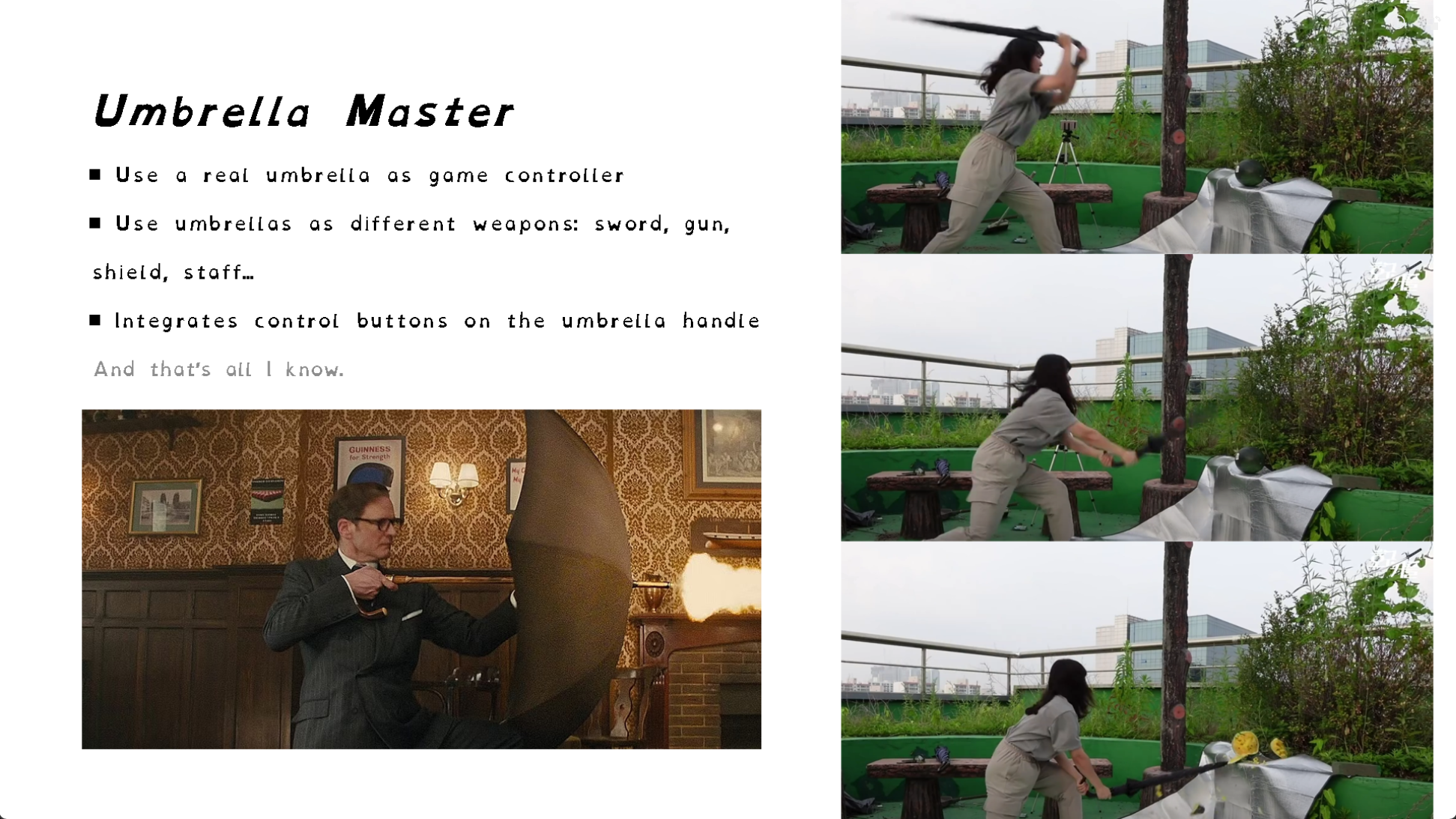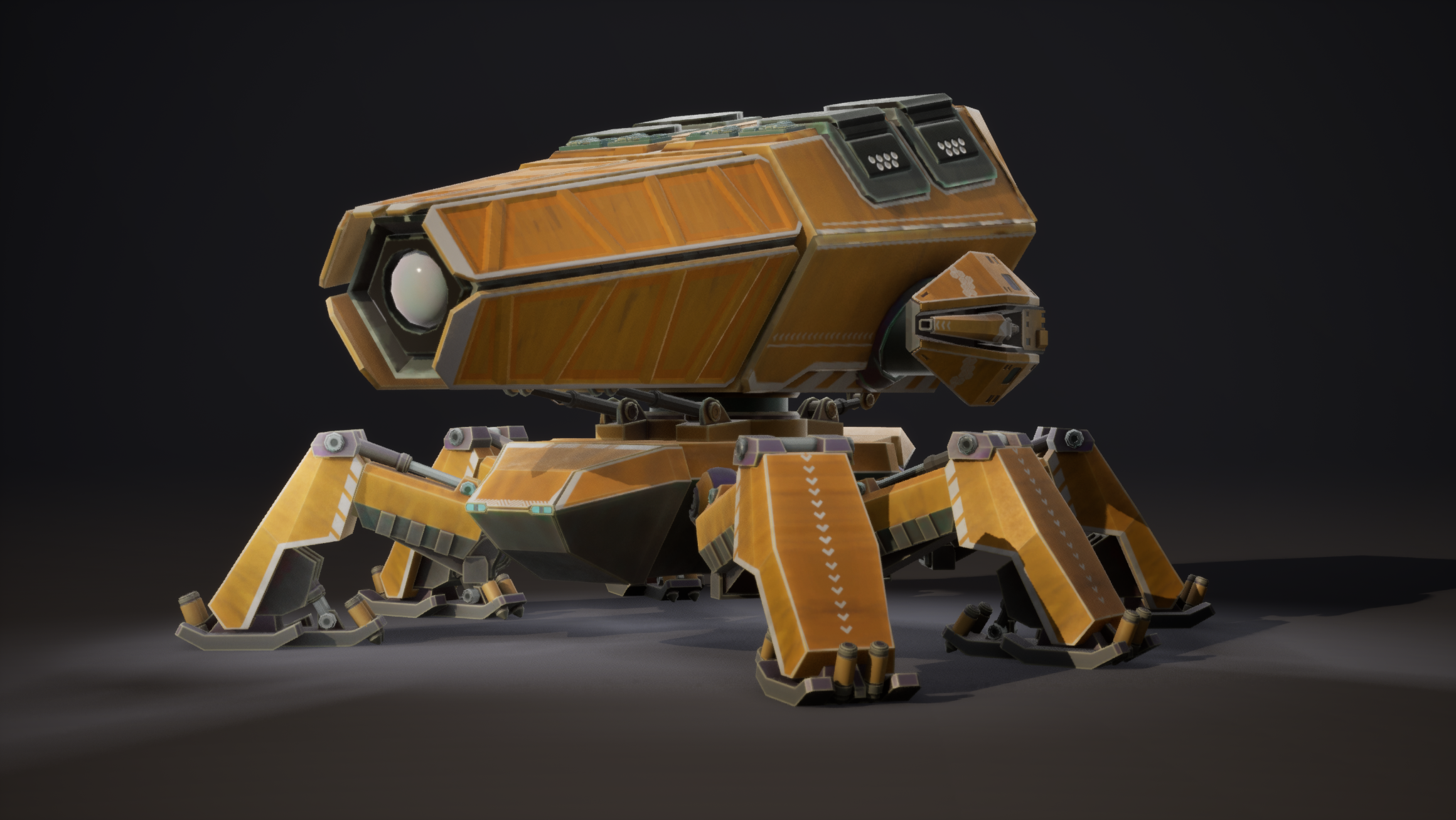Dev Log #1 - Umbrella Master: From Pitch to Glitch (We fixed it!)
Introduction
Hello everyone! Welcome to the first developer log for Umbrella Master. I’d like to share with you how Umbrella Master evolved from its initial concept to where it is today.
Starting Point
The story begins with a course requirement for the Alt Control class. During the ideation phase, I kept thinking about everyday objects that are both familiar and possess potential for transformation and interaction, suitable for being adapted into a unique controller. Ultimately, the image of an umbrella popped into my mind.
Why an umbrella? Because it naturally has multiple forms: it can be swung when closed, and used for defense when opened. More importantly, almost everyone instinctively knows how to use an umbrella upon seeing one. Based on this intuitive interaction potential, I decided to make it my controller.
When initially pitching this idea, I specifically referenced the cool spy umbrella from the movie Kingsman as an example—it can defend, it can shoot, players immediately get what it could become.
 ↑ The One Page created for the pitch at that time
↑ The One Page created for the pitch at that time
At that time, I had preliminary ideas about the various uses of the umbrella, but the specific gameplay was still quite vague. The actual gameplay design gradually became clear after our team was formed.
Prototype
The idea was there, the team was assembled, next step: get to work! We only had about three weeks for prototype development. To focus our efforts on polishing the core umbrella interaction experience, we quickly decided on the basic game framework and gameplay: the player fights a Boss in a fixed arena. This allowed us to temporarily ignore complex elements like movement and story.
The core gameplay was also quickly determined: swinging the umbrella generates sword slashes and shots as offensive means, while opening the canopy is used for defense.
To achieve this, we needed the controller to be able to:
- Get the overall pose information of the umbrella to detect swings
- Get the open/closed state of the canopy to trigger defense
At the same time, we wanted the player to be able to perform simple movements (dodging) and shooting actions, so we added a joystick: pushing left/right dodges, pushing forward/backward shoots.
Thus, the first controller prototype was born: we used an ESP32 as the main controller, connected an IMU to capture rotation; another IMU was added to the canopy, using the combination of the two data to calculate the canopy’s open/close state. Finally, a joystick module was added. To integrate these electronic components, we designed and 3D printed a new umbrella handle, replacing the original small plastic one.
For specific technical details about the controller, please look forward to our second developer log.
The game itself was developed using the Unity engine, mainly because connecting and debugging the controller is relatively convenient. The art team started working on models and effects simultaneously, using basic geometric shapes as placeholders for less critical elements at the begining. We also designed some simple Boss abilities so players could experience basic move interactions.
The biggest challenge during this phase was undoubtedly ensuring the controller could be built and function properly on time. There was a major setback along the way; after soldering all the components, the entire umbrella became completely unresponsive, which honestly made me break down for a bit. After resting for a few days, I slowly started checking for problems step by step, and thankfully, a solution was eventually found.
↑ Video recorded during the prototype phase
Exploration & Expansion
After the prototype phase, we were happy that our project was selected to continue, and our team was expanded.
The initial goal for this phase was to complete two different levels, each with a uniquely designed Boss. We basically completed the Boss design and mechanism implementation for the first level. Meanwhile, art assets and effects were gradually enriched, making the game look much more polished than in the prototype stage.
 ↑ Newly created Boss model and textures
↑ Newly created Boss model and textures
The controller itself was also planned for a major evolution. We listed many upgrades we wanted to achieve: built-in battery, wireless connection, adding a vibration motor for enhanced feedback, and even researching the use of UWB chips for spatial positioning, replacing joystick dodging with the player’s physical movement. We conducted extensive technical feasibility studies and redesigned the casing to accommodate these new components.
However, testing during the Alpha phase also revealed some issues. The most obvious was the difficulty in balancing the numbers; the Boss was either very week and died in a few hits, or so strong that players couldn’t possibly win.
Right at this time, we had the opportunity to attend GDC. There, we saw many other exciting alt-control games, which gave us a lot of inspiration. After returning, we realized we might need to adjust our direction to make the game better in the Beta and polishing stages.
Power!
Returning from GDC, we made several important adjustments:
First, goodbye health bars, hello scores: We decided to ditch the traditional health system in favor of a score-based one. We found that for this game, the focus perhaps shouldn’t be on the pressure of winning or losing, but rather on letting players enjoy the fun of performing various actions with the umbrella itself, providing a frustration-free play environment.
Second, enhance feedback, improve the physical sensation: We planned to optimize various effects to make the impact of swings, the visual feedback of shots, and the blocking feedback of defense more pronounced (paired with the new vibration motor, the effect is quite good). The goal is to let players intuitively feel the satisfaction of playing with this special umbrella, rather than just pursuing the sense of accomplishment from defeating the Boss.
Then we decided that quality is greater than quantity: Based on the score system and the fun-first principle, we realized we no longer needed to insist on creating two levels. Especially in situations like exhibitions where players spend limited time at a booth, quickly conveying the core fun is far more important than showcasing the number of levels.
It was also during this stage that we completed the assembly of the new generation controller hardware. I can say it’s considerably more complex and highly integrated than before. However, the new controller has encountered continuous problems during the integration and debugging phase. As of now, we are still actively debugging and seeking better algorithms and solutions. However, the current version of the controller is still very unstable (perhaps even less stable than the initial one, maybe due to more features), and our algorithms still have significant room for improvement. What the final result will be remains to be seen.
So…
So… that’s the growth story of Umbrella Master so far: from a simple class idea to a project that has undergone prototype validation, direction adjustments, and is still grappling with complex hardware and algorithms. Although challenges lie ahead, especially the urgent need to resolve controller stability issues, we are confident in the unique core experience of fighting with a real umbrella. Even if we can’t achieve long-term stable gameplay in the end, I believe even a quick experience of this game can bring you a lot of fun. And finally, I think the experience of making this game and this umbrella is even more valuable.
Umbrella Master
Become the Umbrella Master with a real umbrella controller!
| Status | Released |
| Authors | Ziduan, Mengqian(Akane)Liu, Sapphire_starr, Zhuojun Wei, Liyian Zhu, ZHAOYIFENG |
| Genre | Action |
| Tags | 3D, First-Person, motion-control, unique-controller, Unity |
More posts
- Dev Shorts #1 - Blood-Enhanced Umbrella55 days ago
- Dev Log #2 - Umbrella Maker: Building the Hardware56 days ago
- 开发小日志 #1 - 血祭控制器56 days ago
- 开发日志 #2 - 造伞大师:建模打印焊接硬件一条龙56 days ago
- 开发日志 #1 - 雨伞大师:从入门到放弃(还没!)56 days ago

Leave a comment
Log in with itch.io to leave a comment.